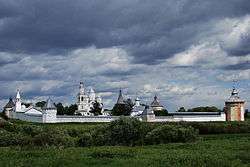Spaso-Prilutsky Monastery
|
General view of the monastery | |
| Monastery information | |
|---|---|
| Full name | Спасо-Прилуцкий Димитриев монастырь |
| Order | Russian Orthodox Church |
| Established | 1371, 1991 |
| Disestablished | 1924 |
| Diocese | Vologda and Veliky Ustyug Eparchy |
| People | |
| Founder(s) | Dmitry Prilutsky |
| Site | |
| Location | Vologda, Vologda Oblast, Russia |
| Coordinates | Coordinates: 59°15′44″N 39°53′22″E / 59.26222°N 39.88944°E |
| Public access | Yes |
The Spaso-Prilutsky Monastery (Russian: Спасо-Прилуцкий Димитриев монастырь) is a Russian Orthodox monastery outside the old city of Vologda, Russia, on the bank of the Vologda River. As of 2011, it was one of the four monasteries still operating in the region. Its history goes back to the 14th-century missionary activities of St. Sergius of Radonezh and his disciples.
History
The monastery was founded by Dmitry Prilutsky, formerly a hegumen of the Nikolsky Monastery in Pereslavl-Zalessky. Dmitry left Pereslavl since he thought it was too crowded, and moved north. He first decided to settle down on the Obnora River, currently in Gryazovetsky District of Vologda Oblast, but he was not accepted warmly by the local population, and he moved further north. At the current location of the monastery, which was at the time relatively far from the city of Vologda, he built a wooden church and the cells.[1]
The end of the 14th century was the time of rapid expansion of the Grand Duchy of Moscow, and Dmitry Donskoy, the prince of Moscow, considered it very important as an influence point of the Moscow State in the north. The princes of Moscow and later tsars belonged to the main benefactors of the monastery. Vasily III visited the monastery personally in 1528, when he and his wife, Elena Glinskaya, childless for a long time, made a pilgrimage to a number of Russian monasteries in hope to get a child. (The child who was eventually born was Ivan the Terrible). On December 16, 1612, the monastery was captured and burned by Polish-Lithuanian brigands, the so-called Lisowczycy.
In August 1924, the monastery was abolished. The buildings were subsequently used for a variety of purposes, including living quarters, a prison, a depot, and a museum. All the buildings consisting the ensemble of the monastery were preserved though. In 1991, the monastery was re-established.[2] The selo of Priluki, where the monastery was located, in 1993 was included into the city of Vologda.
As of January 2013, images of the monastery and grounds were available via Google Street View.
Architecture
The monastery is built as a fortress, has an approximately rectangular shape, and is completely surrounded by a wall, which has four corner towers and three gates. The northern wall has the main gate and the gate Resurrection Church, the western wall has a gate leading to the Vologda River, and the southern wall has the third gate which is now defunct. The wall was completed in 1656. The construction started after the monastery was plundered by Polish armies in the Time of Troubles.[1]
The main cathedral, located in the center of the monastery, is the Saint Saviour Cathedral, built in 1537-1542. It was the first stone building in Vologda. The bell-tower was built between 1639 and 1654. In 1811, the cathedral burnt down and was only restored in 1813-1817. In the meanwhile, during the French invasion of Russia, the Napoleon army occupied Moscow, and some of the treasures belonging to the church were speedily evacuated from Moscow. They were kept in Spaso-Prilutsky Monastery, in the cathedral which at the time was still not restored. The cathedral is connected to a set of buildings, including the Presentation Church, built before 1623.[1]
The Church of All Saints was built in 1721, and the Church of Saint Catherine originates from 1830.
In 1962, the wooden Assumption Church, which was formerly located in the Alexandro-Kushtsky Monastery close to the selo of Ustye, was transferred to the Spaso-Prilutsky Monastery. This is one of the earliest surviving wooden buildings in Russia.[1]
References
| Wikimedia Commons has media related to Spaso-Prilutsky Monastery. |
- 1 2 3 4 История и архитектура (in Russian). Спасо-Прилуцкий Димитриев монастырь. Retrieved 19 December 2011.
- ↑ Современность монастыря (in Russian). Спасо-Прилуцкий Димитриев монастырь. Retrieved 19 December 2011.
